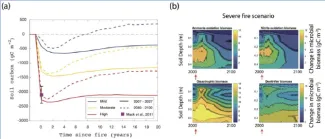The accurate representation of microbial functional guilds within ecosystem models is critical for predicting ecosystem recovery on multi-decadal time scales.
As the Arctic becomes warmer and drier, the outbreak of severe wildfires is becoming more frequent. The onset of wildfire leads to the combustion and loss of carbon from soil and vegetation, and the continual export of soil nutrients to waterways. Bouskill et al. (2022) used a well-tested, process-rich model, ecosys, to simulate the response of the soil carbon and nutrient cycles to acute wildfire onset and chronic changes in climate. The foundation for the model spin-up was the 2007 Anaktuvuk river fire, one of the largest and most comprehensively sample wildfires in high-latitude systems. Model performance was evaluated by comparison to data from the site and included pre- and post-fire net primary productivity, soil carbon stocks, and physicochemical variables. Once benchmarking was complete, several questions were addressed, including (1) what the long-term ramifications of fire disturbance are against the backdrop of ongoing climate change across the twenty-first century, and (2) what role the belowground microbial community plays in enabling the recovery of the aboveground plant community. Bouskill et al. found that over the first 5 years post-fire, fast-growing bacterial heterotrophs colonize regions of the soil previously occupied by slower-growing saprotrophic fungi. The bacterial heterotrophs mineralize organic matter, releasing nutrients into the soil. This pathway outweighs new sources of nitrogen (e.g., nitrogen fixation), reestablishes the biogeochemical equilibrium, and facilitates the recovery of plant productivity.
Citation: Bouskill, N. J., Z. A. Mekonnen, Q. Zhu, W. J. Riley, and R. F. Grant. 2022. “Microbial contribution to post-fire tundra ecosystem recovery over the 21st century.” Communications Earth and Environment 3: 26. https://doi.org/10.1038/s43247-022-00356-2.


